C Exercises: Delete the last node of Singly Linked List
C Linked List : Exercise-9 with Solution
Write a program in C to delete the last node of Singly Linked List.
Pictorial Presentation:
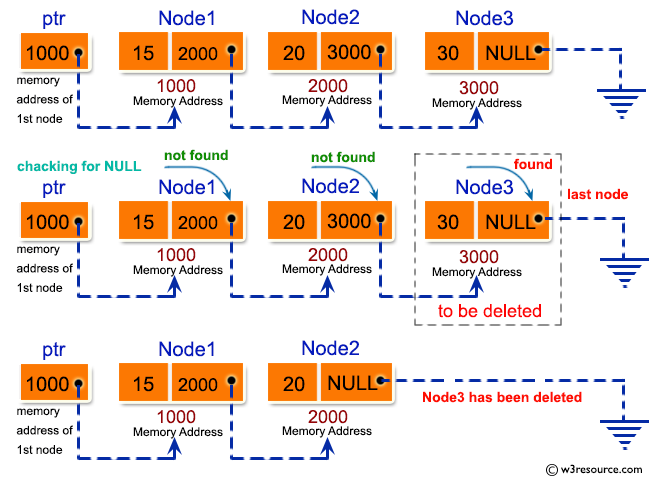
Sample Solution:
C Code:
#include <stdio.h>
#include <stdlib.h>
struct node
{
int num; //Data of the node
struct node *nextptr; //Address of the node
}*stnode;
void createNodeList(int n); //function to create the list
void LastNodeDeletion(); //function to delete the last nodes
void displayList(); //function to display the list
int main()
{
int n,num,pos;
printf("\n\n Linked List : Delete the last node of Singly Linked List :\n");
printf("---------------------------------------------------------------\n");
printf(" Input the number of nodes : ");
scanf("%d", &n);
createNodeList(n);
printf("\n Data entered in the list are : \n");
displayList();
LastNodeDeletion();
printf("\n The new list after deletion the last node are : \n");
displayList();
return 0;
}
void createNodeList(int n)
{
struct node *fnNode, *tmp;
int num, i;
stnode = (struct node *)malloc(sizeof(struct node));
if(stnode == NULL) //check whether the stnode is NULL and if so no memory allocation
{
printf(" Memory can not be allocated.");
}
else
{
// reads data for the node through keyboard
printf(" Input data for node 1 : ");
scanf("%d", &num);
stnode-> num = num;
stnode-> nextptr = NULL; //Links the address field to NULL
tmp = stnode;
//Creates n nodes and adds to linked list
for(i=2; i<=n; i++)
{
fnNode = (struct node *)malloc(sizeof(struct node));
if(fnNode == NULL) //check whether the fnnode is NULL and if so no memory allocation
{
printf(" Memory can not be allocated.");
break;
}
else
{
printf(" Input data for node %d : ", i);
scanf(" %d", &num);
fnNode->num = num; // links the num field of fnNode with num
fnNode->nextptr = NULL; // links the address field of fnNode with NULL
tmp->nextptr = fnNode; // links previous node i.e. tmp to the fnNode
tmp = tmp->nextptr;
}
}
}
}
// Deletes the last node of the linked list
void LastNodeDeletion()
{
struct node *toDelLast, *preNode;
if(stnode == NULL)
{
printf(" There is no element in the list.");
}
else
{
toDelLast = stnode;
preNode = stnode;
/* Traverse to the last node of the list*/
while(toDelLast->nextptr != NULL)
{
preNode = toDelLast;
toDelLast = toDelLast->nextptr;
}
if(toDelLast == stnode)
{
stnode = NULL;
}
else
{
/* Disconnects the link of second last node with last node */
preNode->nextptr = NULL;
}
/* Delete the last node */
free(toDelLast);
}
}
// function to display the entire list
void displayList()
{
struct node *tmp;
if(stnode == NULL)
{
printf(" No data found in the empty list.");
}
else
{
tmp = stnode;
while(tmp != NULL)
{
printf(" Data = %d\n", tmp->num); // prints the data of current node
tmp = tmp->nextptr; // advances the position of current node
}
}
}
Sample Output:
Linked List : Delete the last node of Singly Linked List :
---------------------------------------------------------------
Input the number of nodes : 3
Input data for node 1 : 1
Input data for node 2 : 2
Input data for node 3 : 3
Data entered in the list are :
Data = 1
Data = 2
Data = 3
The new list after deletion the last node are :
Data = 1
Data = 2
Flowchart:
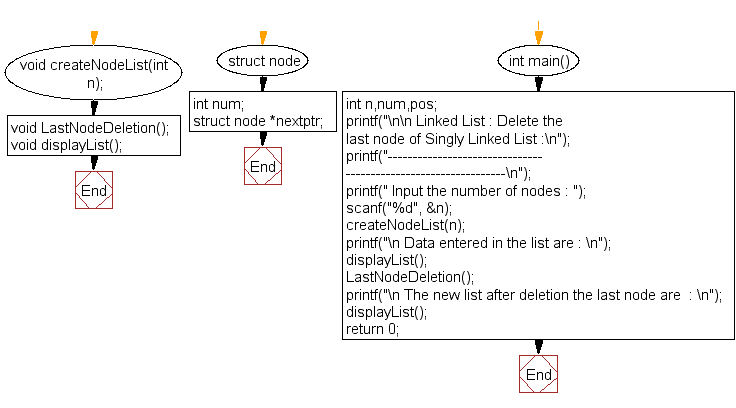
createNodeList() :
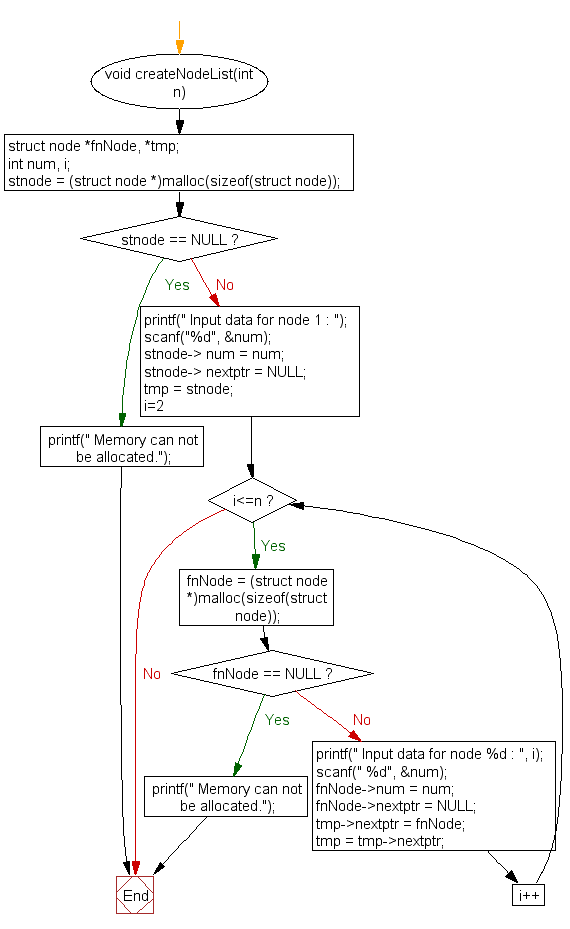
LastNodeDeletion() :
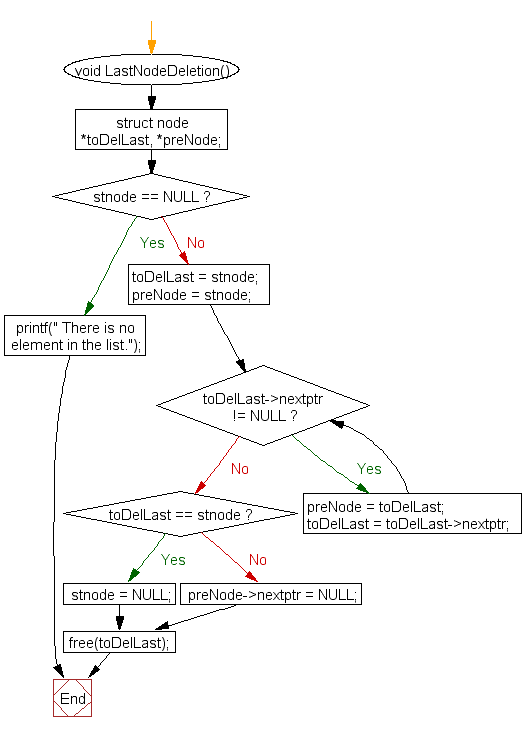
displayList() :
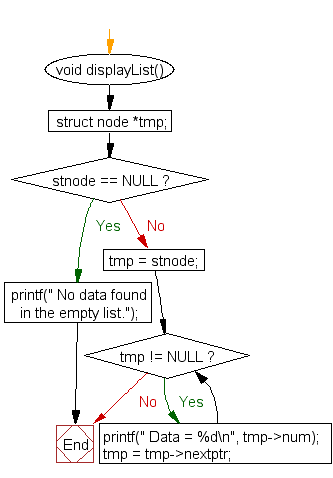
C Programming Code Editor:
Have another way to solve this solution? Contribute your code (and comments) through Disqus.
Previous: Write a program in C to delete a node from the middle of Singly Linked List.
Next: Write a program in C to search an existing element in a singly linked list.
What is the difficulty level of this exercise?
Test your Programming skills with w3resource's quiz.
C Programming: Tips of the Day
Static variable inside of a function in C
The scope of variable is where the variable name can be seen. Here, x is visible only inside function foo().
The lifetime of a variable is the period over which it exists. If x were defined without the keyword static, the lifetime would be from the entry into foo() to the return from foo(); so it would be re-initialized to 5 on every call.
The keyword static acts to extend the lifetime of a variable to the lifetime of the programme; e.g. initialization occurs once and once only and then the variable retains its value - whatever it has come to be - over all future calls to foo().
Ref : https://bit.ly/3fOq7XP
- New Content published on w3resource:
- HTML-CSS Practical: Exercises, Practice, Solution
- Java Regular Expression: Exercises, Practice, Solution
- Scala Programming Exercises, Practice, Solution
- Python Itertools exercises
- Python Numpy exercises
- Python GeoPy Package exercises
- Python Pandas exercises
- Python nltk exercises
- Python BeautifulSoup exercises
- Form Template
- Composer - PHP Package Manager
- PHPUnit - PHP Testing
- Laravel - PHP Framework
- Angular - JavaScript Framework
- Vue - JavaScript Framework
- Jest - JavaScript Testing Framework
